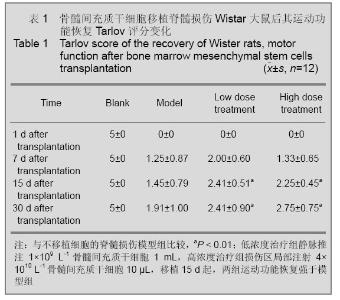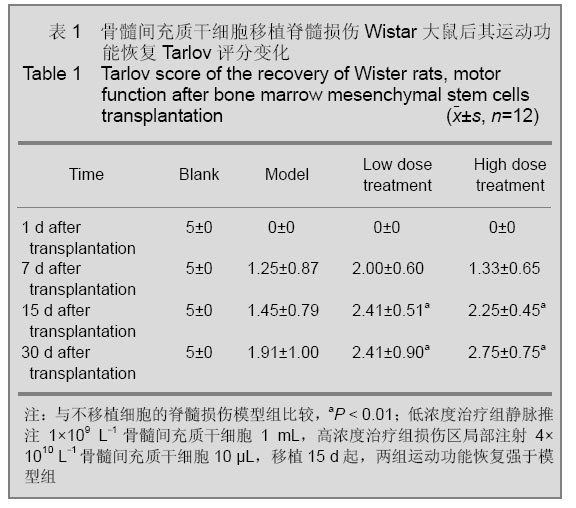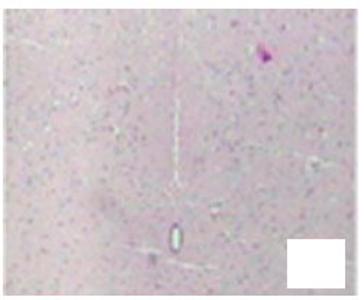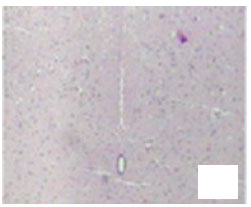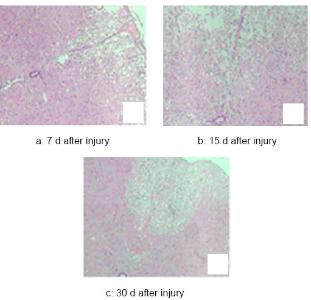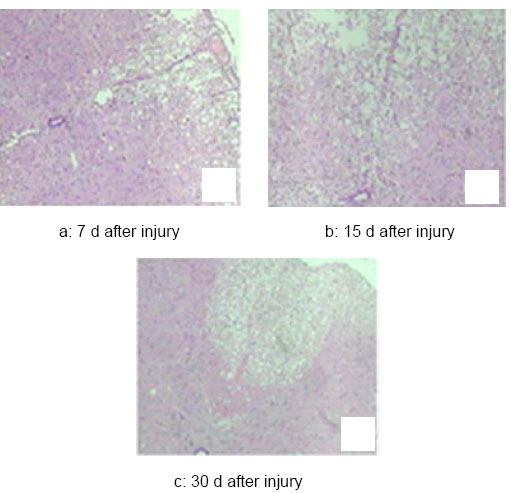Chinese Journal of Tissue Engineering Research ›› 2012, Vol. 16 ›› Issue (49): 9209-9213.doi: 10.3969/j.issn.2095-4344.2012.49.016
Previous Articles Next Articles
Bone marrow mesenchymal stem cells repair Wistar rat spinal cord injury
Jia Quan-zhang1, Li Dong-jun2, Chen Yu-bing3, Sun Jing-hai1, Wang Feng-hua1, Xu Shuang1, Liu Li-ping3, Gao De-xuan2, Jiang Da-wei2
- 1No.208 Hospital of Chiinese Liberation Army, Changchun 130062, Jilin Province, China; 2Department of Medicine, Yanbian University, Yanji 133002, Jilin Province, China; 3The Second Affiliated Hospital of Jilin University, Changchun 130062, Jilin Province, China
-
Received:2012-05-04Revised:2012-06-22Online:2012-12-02Published:2013-01-16 -
About author:Jia Quan-zhang☆, Doctor, Chief physician, No.208 Hospital of Chinese Liberation Army, Changchun 130062, Jilin Province, China jqz208@sohu.com -
Supported by:jlin Science and Technology Development Planning Program, No. 20080446*
CLC Number:
Cite this article
Jia Quan-zhang, Li Dong-jun, Chen Yu-bing, Sun Jing-hai, Wang Feng-hua, Xu Shuang, Liu Li-ping, Gao De-xuan, Jiang Da-wei. Bone marrow mesenchymal stem cells repair Wistar rat spinal cord injury [J]. Chinese Journal of Tissue Engineering Research, 2012, 16(49): 9209-9213.
share this article
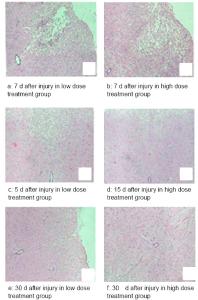
注:低浓度治疗组静脉推注1×109 L-1骨髓间充质干细胞1 mL,高浓度治疗组损伤区局部注射4×1010 L-1骨髓间充质干细胞10 μL,于损伤7 d见组织水肿减轻,炎性细胞浸润减轻,空泡变性减轻,神经细胞形态恢复,结构排列完整,第15天神经细胞形态恢复及结构排列较第7天又有改善,第30天又较第15天神经细胞形态恢复及结构排列有改善 Figure 3 Histopathological changes of rat spinal tissue in the treatment groups at different time points after spinal cord injury (hematoxylin-eosin staining, ×40) 图3 治疗组大鼠脊髓损伤不同时间点组织病理学变化(苏木精-伊红染色,×40) Figure 3 Histopathological changes of rat spinal tissue in the treatment groups at different time points after spinal cord injury (hematoxylin-eosin staining, ×40) 图3 治疗组大鼠脊髓损伤不同时间点组织病理学变化(苏木精-伊红染色,×40)"

| [1] De Haro J,Zurita M,Avllon L, et al. Detection of 111 ln-oxme-labeled hone marrow stromal cells after intravenous or intralesional administration in chronic paraplegicrats. Neurosci Letters. 2005,377(3):7.[2] Xu F, Chen JM, Zhang X. Chuangshang Waike Zahi. 2007; 9(1):91-93.徐帆,陈建敏,张晓.脊髓损伤动物模型的制备及神经功能评价[J]..创伤外科杂志,2007,9(1):91-93.[3] Cheng H , Cao Yih ai, Olson L . Spinal cord repair in adult paralegic rats: partial restoration of hind limb function. Science. 1996;273(7): 510-513.[4] Rietze RL,Reynolds BA.Neural stem cell isolation and characterization .Methods Enzymol,2006;41(9):3-23. [5] Marshall CT,Lu C,Winstead W,et al.The therapeutic potential of human olfactory-derived stem cells.Histol Histopathol. 2006;21(6):633-643.[6] Girard C,Bemelmans AP,Dufour N,et al.Grafts of brain derived neurotrophic factor and neurotrophin transduced primate Sehwann cells lead to functional recovery of the demyelinated mouse spinal cord.J Neurosci.2005;25(35):7924-7933.[7] Nandoe Tewarie RD,Hurtado A,LeviAD,et al.Bone marrow stro.mal cells for repair of the spinal cord:towards clinical application.Cell Transplant.2006;15(7):563-577.[8] Chapel A, Bertho JM, Bensidhoum M, et al. Mesenchymal stem cells home to injured tissues when co-infused with hematopoietic cells to treat a radiation-induced multi-organ failure syndrome. J Gene Med.2003; 5(12):1028.[9] Neuhuber B,Himes BT,Shumsky JS,et al.Axon growth and recovery of function supported by human bone marrow stromal cells in the injured spinal cord exhibit donor variations. Brain Res.2005;1035(1):73.[10] Chopp M,Zhang XH,Li Y,et al.Spinal cord injury in rat:treatment with bone marrow stromal cell transplantation. Neuro Report.2000;11(11):3001.[11] Hofstetter CP, Schwarz EJ,Hess D,et al.Marrow stromal cells from gaiding strands in the injured spinal cord and promote recovery.PracNatl Acad Sci USA.2002;99(4):2199.[12] Statake K,Lou J,Lenke LG. Migration of mesenchymal stem cells through cerebrospinal fluid into injured spinal cord tissue. Spine.2004;29(18):71.[13] Zurita M, Vaquero J.Bone marrow stromal cells can achieve cure of chronic paraplegic rats: functional and morphological outcome one year after transplantati0n.Neurosci Lett.2006; 402(1):51.[14] Wright B,Himes BT,Shumsky JS,et al. Axon growth and recovery of function supported by human bone marrow stromal cells in the injured spinal cord exhibit donor variations. Brain Res. 2005;1035(1):73.[15] Brazelton TR,Rossi FM,Keshet GI,et al. From marrow to brain:expression of neuronal phenotypes in adult mice. Science. 2000;290:1779.[16] Liu CL, Wu Y. Zhongguo Zuzhi Gongcheng Yanjiu yu Linchuang Kangfu.2011;15(2):6051-6054.刘长路,吴岩.干细胞移植治疗脊髓损伤的研究进展[J].中国组织工程研究与临床康复,2011,15(32):6051-6054. |
| [1] | Lyu Ruyue, Gu Lulu, Liu Qian, Zhou Siyi, Li Beibei, Xue Letian, Sun Peng. Regulatory mechanisms of exosome secretion and its application prospects in biomedicine [J]. Chinese Journal of Tissue Engineering Research, 2026, 30(1): 184-193. |
| [2] | Xu Canli, He Wenxing, Wang Yuping, Ba Yinying, Chi Li, Wang Wenjuan, Wang Jiajia. Research context and trend of TBK1 in autoimmunity, signaling pathways, gene expression, tumor prevention and treatment [J]. Chinese Journal of Tissue Engineering Research, 2026, 30(在线): 1-11. |
| [3] | Liu Xun, Ouyang Hougan, Pan Rongbin, Wang Zi, Yang Fen, Tian Jiaxuan . Optimal parameters for physical interventions in bone marrow mesenchymal stem cell differentiation [J]. Chinese Journal of Tissue Engineering Research, 2025, 29(31): 6727-6732. |
| [4] | Hu Enxi, He Wenying, Tao Xiang, Du Peijing, Wang Libin. Regulation of THZ1, an inhibitor of cyclin-dependent kinase 7, on stemness of glioma stem cells and its mechanism [J]. Chinese Journal of Tissue Engineering Research, 2025, 29(25): 5374-5381. |
| [5] | Lin Meiyu, Zhao Xilong, Gao Jing, Zhao Jing, Ruan Guangping. Action mechanism and progress of stem cells against ovarian granulosa cell senescence [J]. Chinese Journal of Tissue Engineering Research, 2025, 29(25): 5414-5421. |
| [6] | Tian Zhenli, Zhang Xiaoxu, Fang Xingyan, Xie Tingting. Effects of sodium arsenite on lipid metabolism in human hepatocytes and regulatory factors [J]. Chinese Journal of Tissue Engineering Research, 2025, 29(23): 4956-4964. |
| [7] | Han Fang, Shu Qing, Jia Shaohui, Tian Jun. Electrotactic migration and mechanisms of stem cells [J]. Chinese Journal of Tissue Engineering Research, 2025, 29(23): 4984-4992. |
| [8] | Hu Chen, Jiang Ying, Chen Jia, Qiao Guangwei, Dong Wen, Ma Jian. Preparation and characterization of alendronate/chitosan/polyvinyl alcohol composite hydrogel films [J]. Chinese Journal of Tissue Engineering Research, 2025, 29(22): 4720-4730. |
| [9] | Yang Chao, Luo Zongping. Small molecule drug TD-198946 enhances osteogenic differentiation of rat bone marrow mesenchymal stem cells [J]. Chinese Journal of Tissue Engineering Research, 2025, 29(13): 2648-2654. |
| [10] | Li Xiaofeng, Zhao Duo, Ouyang Qin, Pang Zixiang, Li Yuquan, Chen Qianfen. Protective effect of mangiferin on oxidative stress injury in rat bone marrow mesenchymal stem cells [J]. Chinese Journal of Tissue Engineering Research, 2025, 29(13): 2669-2674. |
| [11] | Hu Zezun, Yang Fanlei, Xu Hao, Luo Zongping. Effect of surface roughness of polydimethylsiloxane on osteogenic differentiation of bone marrow mesenchymal stem cells under stretching conditions [J]. Chinese Journal of Tissue Engineering Research, 2025, 29(10): 1981-1989. |
| [12] | Yang Zhihang, Sun Zuyan, Huang Wenliang, Wan Yu, Chen Shida, Deng Jiang. Nerve growth factor promotes chondrogenic differentiation and inhibits hypertrophic differentiation of rabbit bone marrow mesenchymal stem cells [J]. Chinese Journal of Tissue Engineering Research, 2025, 29(7): 1336-1342. |
| [13] | Huang Ting, Zheng Xiaohan, Zhong Yuanji, Wei Yanzhao, Wei Xufang, Cao Xudong, Feng Xiaoli, Zhao Zhenqiang. Effects of macrophage migration inhibitory factor on survival, proliferation, and differentiation of human embryonic stem cells [J]. Chinese Journal of Tissue Engineering Research, 2025, 29(7): 1380-1387. |
| [14] | Liu Haowen, Qiao Weiping, Meng Zhicheng, Li Kaijie, Han Xuan, Shi Pengbo. Regulation of osteogenic effects by bone morphogenetic protein/Wnt signaling pathway: revealing molecular mechanisms of bone formation and remodeling [J]. Chinese Journal of Tissue Engineering Research, 2025, 29(3): 563-571. |
| [15] | Zhou Shijie, Li Muzhe, Yun Li, Zhang Tianchi, Niu Yuanyuan, Zhu Yihua, Zhou Qinfeng, Guo Yang, Ma Yong, Wang Lining. Effect of Wenshen Tongluo Zhitong formula on mouse H-type bone microvascular endothelial cell/bone marrow mesenchymal stem cell co-culture system [J]. Chinese Journal of Tissue Engineering Research, 2025, 29(1): 8-15. |
| Viewed | ||||||
|
Full text |
|
|||||
|
Abstract |
|
|||||
